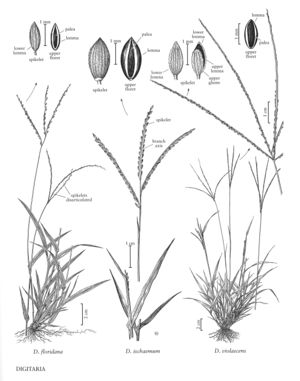Difference between revisions of "Digitaria ischaemum"
FNA>Volume Importer |
FNA>Volume Importer |
||
| Line 23: | Line 23: | ||
-->{{Treatment/Body | -->{{Treatment/Body | ||
|distribution=Idaho;Mont.;Wash.;Conn.;N.J.;N.Y.;Va.;Del.;D.C;Wis.;W.Va.;Md.;Alta.;B.C.;Man.;N.B.;N.S.;Ont.;P.E.I.;Que.;Sask.;Fla.;Wyo.;N.H.;N.Mex.;Tex.;La.;Tenn.;N.C.;S.C.;Pa.;Nev.;Mass.;Maine;R.I.;Vt.;Puerto Rico;Colo.;Virgin Islands;Calif.;Ala.;Kans.;N.Dak.;Nebr.;Okla.;S.Dak.;Ark.;Ill.;Ga.;Ind.;Iowa;Ariz.;Ohio;Utah;Mo.;Minn.;Mich.;Miss.;Ky.;Oreg. | |distribution=Idaho;Mont.;Wash.;Conn.;N.J.;N.Y.;Va.;Del.;D.C;Wis.;W.Va.;Md.;Alta.;B.C.;Man.;N.B.;N.S.;Ont.;P.E.I.;Que.;Sask.;Fla.;Wyo.;N.H.;N.Mex.;Tex.;La.;Tenn.;N.C.;S.C.;Pa.;Nev.;Mass.;Maine;R.I.;Vt.;Puerto Rico;Colo.;Virgin Islands;Calif.;Ala.;Kans.;N.Dak.;Nebr.;Okla.;S.Dak.;Ark.;Ill.;Ga.;Ind.;Iowa;Ariz.;Ohio;Utah;Mo.;Minn.;Mich.;Miss.;Ky.;Oreg. | ||
| − | |discussion=<p | + | |discussion=<p>Digitaria ischaemum is a Eurasian weed that is now common in lawns, gardens, fields, and waste ground in warm-temperate regions throughout the world, including much of the Flora region. Larger plants with 5-7 inflorescence branches 8-15 cm long have been called var. mississippiensis (Gatt.) Fernald, but they intergrade with more typical plants, and so do not merit taxonomic recognition.</p> |
|tables= | |tables= | ||
|references= | |references= | ||
| Line 39: | Line 39: | ||
|basionyms= | |basionyms= | ||
|family=Poaceae | |family=Poaceae | ||
| + | |illustrator=Linda A. Vorobik and Hana Pazdírková | ||
|distribution=Idaho;Mont.;Wash.;Conn.;N.J.;N.Y.;Va.;Del.;D.C;Wis.;W.Va.;Md.;Alta.;B.C.;Man.;N.B.;N.S.;Ont.;P.E.I.;Que.;Sask.;Fla.;Wyo.;N.H.;N.Mex.;Tex.;La.;Tenn.;N.C.;S.C.;Pa.;Nev.;Mass.;Maine;R.I.;Vt.;Puerto Rico;Colo.;Virgin Islands;Calif.;Ala.;Kans.;N.Dak.;Nebr.;Okla.;S.Dak.;Ark.;Ill.;Ga.;Ind.;Iowa;Ariz.;Ohio;Utah;Mo.;Minn.;Mich.;Miss.;Ky.;Oreg. | |distribution=Idaho;Mont.;Wash.;Conn.;N.J.;N.Y.;Va.;Del.;D.C;Wis.;W.Va.;Md.;Alta.;B.C.;Man.;N.B.;N.S.;Ont.;P.E.I.;Que.;Sask.;Fla.;Wyo.;N.H.;N.Mex.;Tex.;La.;Tenn.;N.C.;S.C.;Pa.;Nev.;Mass.;Maine;R.I.;Vt.;Puerto Rico;Colo.;Virgin Islands;Calif.;Ala.;Kans.;N.Dak.;Nebr.;Okla.;S.Dak.;Ark.;Ill.;Ga.;Ind.;Iowa;Ariz.;Ohio;Utah;Mo.;Minn.;Mich.;Miss.;Ky.;Oreg. | ||
|reference=None | |reference=None | ||
| Line 44: | Line 45: | ||
|publication year= | |publication year= | ||
|special status= | |special status= | ||
| − | |source xml=https:// | + | |source xml=https://bibilujan@bitbucket.org/aafc-mbb/fna-data-curation.git/src/314eb390f968962f596ae85f506b4b3db8683b1b/coarse_grained_fna_xml/V25/V25_1071.xml |
|subfamily=Poaceae subfam. Panicoideae | |subfamily=Poaceae subfam. Panicoideae | ||
|tribe=Poaceae tribe Paniceae | |tribe=Poaceae tribe Paniceae | ||
Revision as of 16:13, 30 October 2019
Plants annual or of indefinite duration. Culms 20-55(70) cm, decumbent, branching and rooting at the lower nodes; nodes 3-4. Sheaths glabrous or sparsely pubescent; ligules 0.6-2.5 mm; blades 1.5-9 cm long, 3-5 mm wide, glabrous, with a few papillose-based hairs basally. Panicles terminal and axillary; terminal panicles with 2-7 spikelike primary branches, subdigitate or on 0.5-2 cm rachises; primary branches 6-15.5 cm, axes wing-margined, wings at least 1/2 as wide as the midribs, bearing spikelets in groups of 3, lower portions of the longer pedicels adnate to the axes; secondary branches rarely present; axillary inflorescences always present in some of the lower sheaths, entirely or partially concealed. Spikelets 1.7-2.3 mm, homomorphic, narrowly elliptic. Lower glumes absent or a veinless, membranous rim; upper glumes 1.3-2.3 mm, from 3/4 as long as to equaling the upper lemmas, appressed-pubescent; lower lemmas 1.7-2.3 mm, 7-veined, veins unequally spaced, smooth, pubescent; upper lemmas dark brown at maturity; anthers 0.4-0.6 mm. 2n = 36.
Distribution
Idaho, Mont., Wash., Conn., N.J., N.Y., Va., Del., D.C, Wis., W.Va., Md., Alta., B.C., Man., N.B., N.S., Ont., P.E.I., Que., Sask., Fla., Wyo., N.H., N.Mex., Tex., La., Tenn., N.C., S.C., Pa., Nev., Mass., Maine, R.I., Vt., Puerto Rico, Colo., Virgin Islands, Calif., Ala., Kans., N.Dak., Nebr., Okla., S.Dak., Ark., Ill., Ga., Ind., Iowa, Ariz., Ohio, Utah, Mo., Minn., Mich., Miss., Ky., Oreg.
Discussion
Digitaria ischaemum is a Eurasian weed that is now common in lawns, gardens, fields, and waste ground in warm-temperate regions throughout the world, including much of the Flora region. Larger plants with 5-7 inflorescence branches 8-15 cm long have been called var. mississippiensis (Gatt.) Fernald, but they intergrade with more typical plants, and so do not merit taxonomic recognition.
Selected References
None.
